Part of Pride Month is acknowledging that while American society has come a long way towards accepting lesbians, gays, bisexuals, transgender, and queer folks, there’s still a long way to go and a lot of work for all of us to do. As important as it is to celebrate diversity in things like sexual orientation and gender identity, it’s equally important to shine the light on what’s still wrong so that we can work towards fixing it.
Looking at data from the FBI’s Crime Data Explorer compiled since 1990, what can we learn about hate crimes generally, and anti-LGBTQ+ hate crimes specifically? We’ll dive into the data with a quick note – because hate crimes are dramatically underreported, we’ve weighted the data with academic research from 2019. See the Methodology section for more details.
What Is a Hate Crime?
For the purposes of this report, we are using FBI data, and thus using the FBI definition of a hate crime:
The UCR Program defines hate crime as a committed criminal offense which is motivated, in whole or in part, by the offender’s bias(es) against a race, religion disability, sexual orientation, ethnicity, gender, gender identity. For UCR Program purposes, even if the offenders are mistaken in their perception the victim was a member of a certain group, the offense is still a bias crime because the offender was motivated by bias.
USA Hate Crime Summary
First, let’s look at overall hate crimes in the United States.
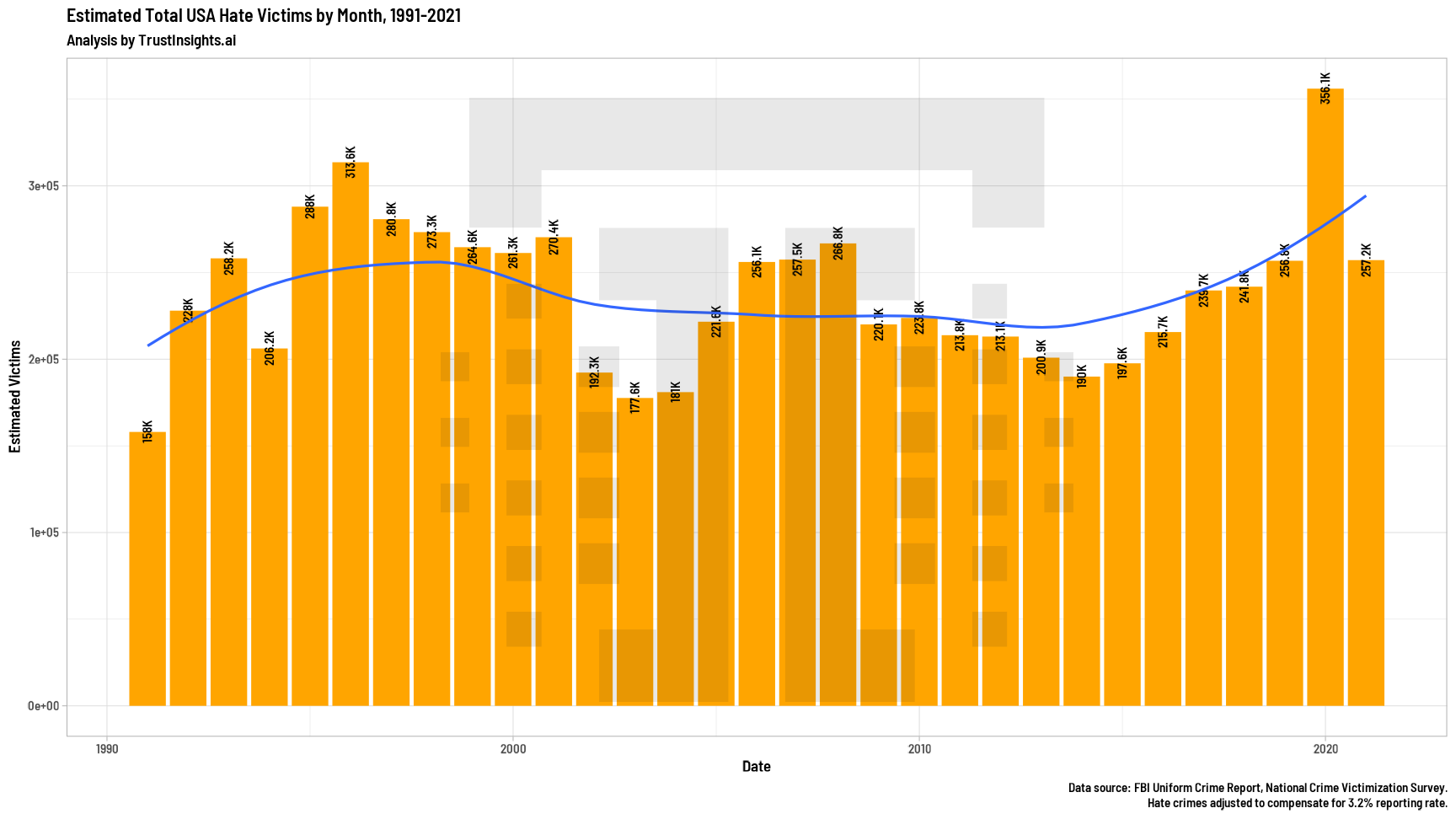 What we see are the peaks and valleys of crime, from a consistent rise in the late 1990s to a gradual decline in the early 2010s to a massive resurgence in the latter part of the last decade. Hate crimes peaked in 2020; in 2021 (the most current data available) we see a return to 2019 levels, but the overall trend (blue line) is on the rise.
What we see are the peaks and valleys of crime, from a consistent rise in the late 1990s to a gradual decline in the early 2010s to a massive resurgence in the latter part of the last decade. Hate crimes peaked in 2020; in 2021 (the most current data available) we see a return to 2019 levels, but the overall trend (blue line) is on the rise.
Looking into the victims more carefully:
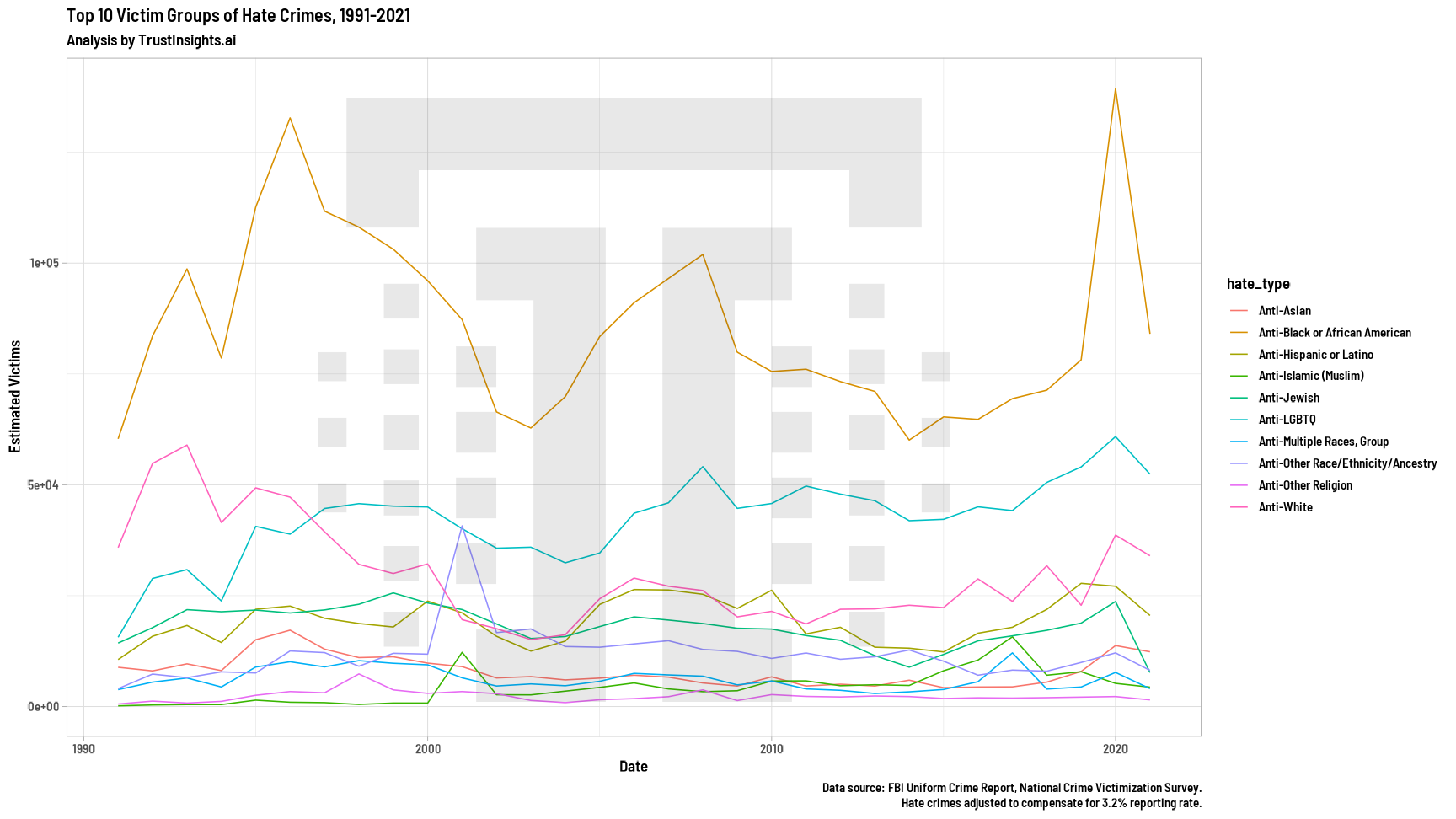 We see that Black Americans suffer the most hate crimes of any group, followed by LGBTQ+ folks and then Jewish folks.
We see that Black Americans suffer the most hate crimes of any group, followed by LGBTQ+ folks and then Jewish folks.
Anti-LGBTQ+ Hate Crime Summary
Let’s now dig into the specifics of anti-LGBTQ+ hate crimes. The category overall is the second-highest number of hate crimes committed besides hate crimes against Black Americans. What do we see in the data?
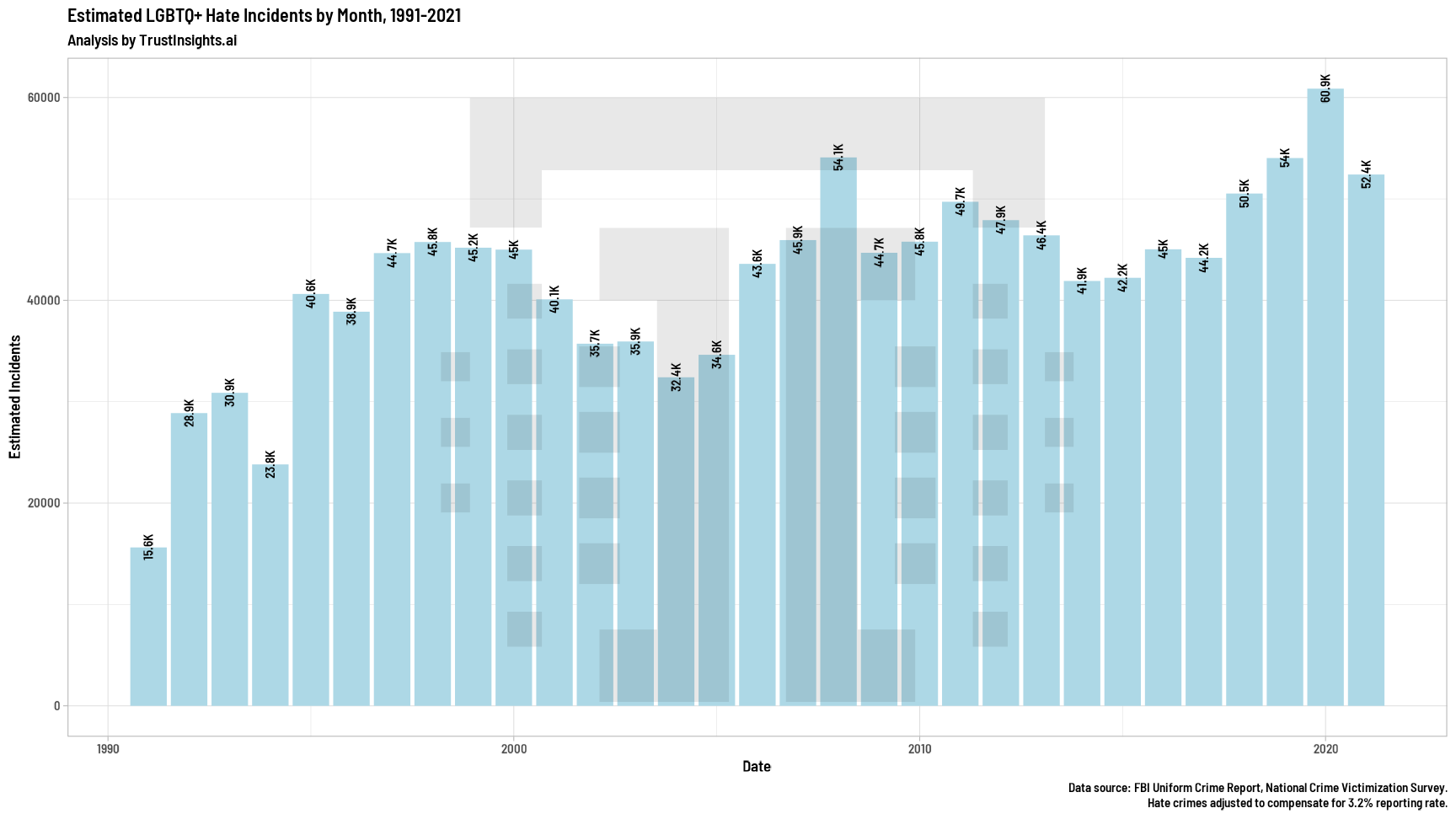 While this mirrors the national trend in broad strokes, overall hate crime rates plateaued in the 2010s for the most part, while they consistently increased for LGBTQ+ folks.
While this mirrors the national trend in broad strokes, overall hate crime rates plateaued in the 2010s for the most part, while they consistently increased for LGBTQ+ folks.
When we look at who is impacted, we see some interesting trends:
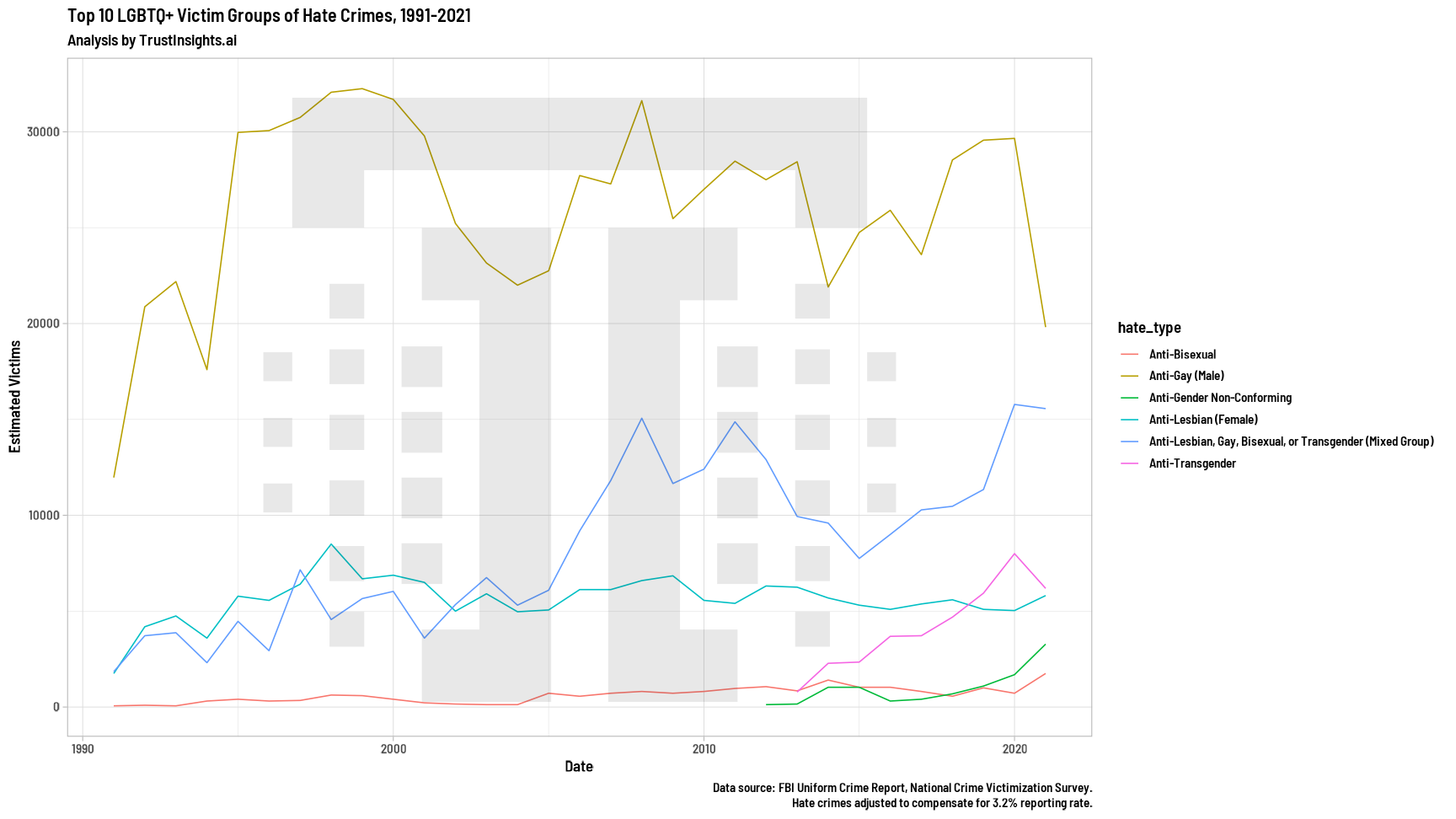 Gay men are the most affected type and have been since UCR data began tracking these crimes in 1990. Anti-lesbian crimes have remained consistent but fell to third place in 2002 behind the mixed group victims. And beginning in 2013, we saw a substantial rise in anti-transgender crimes, pushing them to the third-most impacted people by 2019.
Gay men are the most affected type and have been since UCR data began tracking these crimes in 1990. Anti-lesbian crimes have remained consistent but fell to third place in 2002 behind the mixed group victims. And beginning in 2013, we saw a substantial rise in anti-transgender crimes, pushing them to the third-most impacted people by 2019.
This particular statistic is especially impactful because while approximately 4% of the adult population identifies as lesbian, gay, or bisexual, only 0.6% of the population identifies as transgender, which means transgender people are experiencing dramatically more hate crimes on a per person basis.
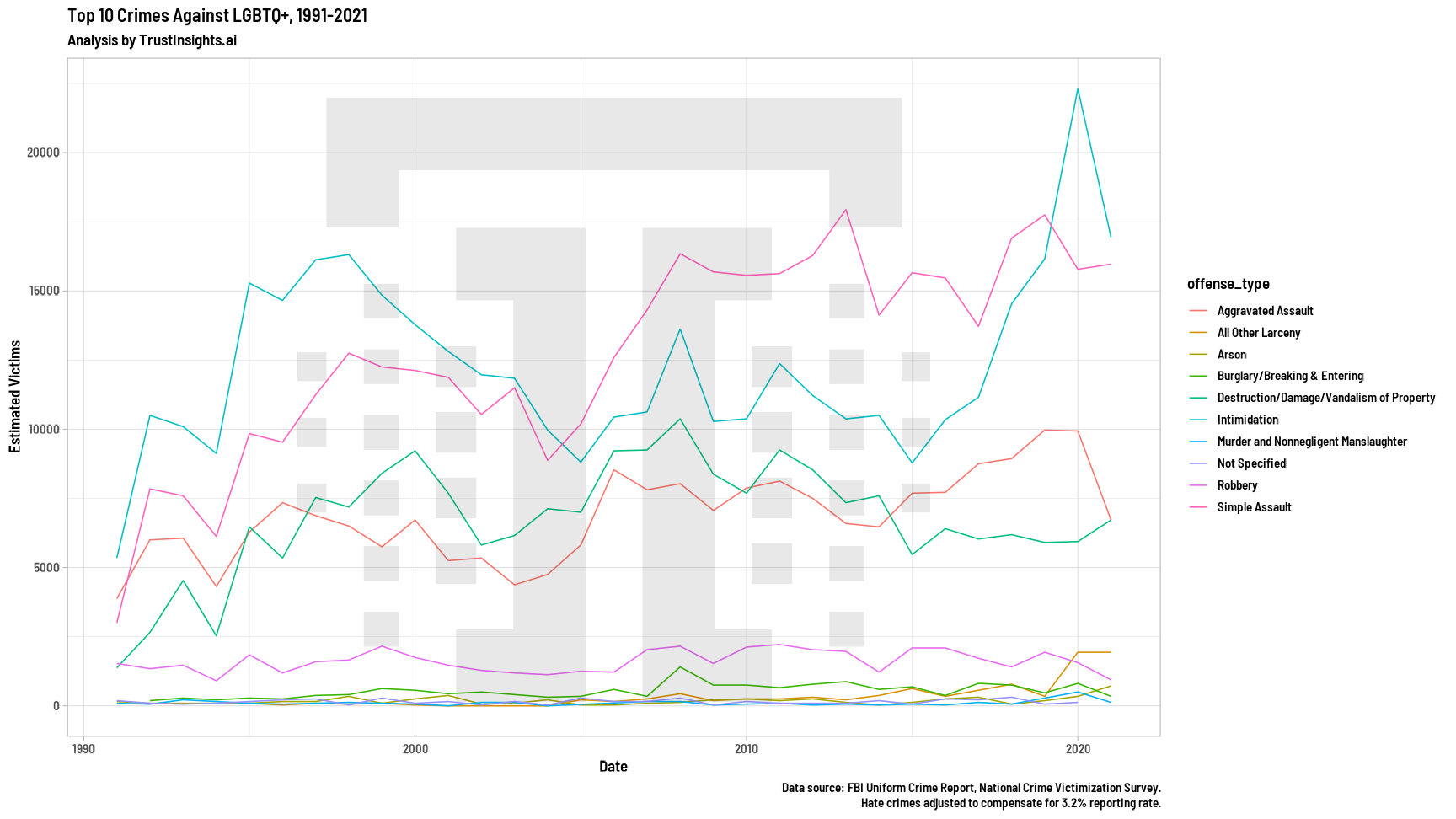 When we examine the types of crimes perpetrated against LGBTQ+ folks, we see that simple assault was the most common crime for much of the last decade, with intimidation taking the top spot for the last 3 years. The FBI definition of intimidation is:
When we examine the types of crimes perpetrated against LGBTQ+ folks, we see that simple assault was the most common crime for much of the last decade, with intimidation taking the top spot for the last 3 years. The FBI definition of intimidation is:
To unlawfully place another person in reasonable fear of bodily harm through the use of threatening words and/or other conduct, but without displaying a weapon or subjecting the victim to actual physical attack.
The third most common category of offense is aggravated assault; simple and aggravated assault are differentiated mainly on the amount of harm done to the victim.
Taken as a whole, this paints a terrible picture for many LGBTQ+ folks of living in fear of bodily harm. The most probable outcome of a criminal encounter is either assault or the threat of assault.
Actions for Allies to Take
In an environment where anti-LGBTQ+ hate crimes are continuously increasing over time, you can play eight critical roles.
- When realistically possible, notify local law enforcement if you witness a crime or are victim of a crime. Criminals thrive when they believe they will go unpunished. This, unfortunately, has to be tempered with an acknowledgement of circumstances – in some places, going to law enforcement may make a situation worse.
- Hate crimes flourish in a culture where hate is encouraged. Do the opposite; speak up in the places you frequent – your workplace, your home, your places of leisure – when you hear hate of any kind being bandied around. Call out offensive jokes, comments, or behaviors. Display symbols showing your affiliation towards and support of discriminated minorities such as Pride symbols, Black Lives Matter symbols, and other ways of indicating you’re an ally, which is important for the next step.
- Encourage friends and colleagues of discriminated minorities to seek you out if they need help or are experiencing any kind of discrimination. This is why visible support is essential, so that friends and colleagues know you’re safe to confide in and ask for help. Given the threat of assault, if you’re able, be a literal buddy to LGBTQ+ folks, helping them to avoid traveling alone in places that may not be safe.
- Support legislation and elected officials who are advancing legislation adding protections for discriminated minorities. Elected officials won’t know something’s a priority unless they hear about it from their constituents. Do this regularly and frequently; just as showing one ad won’t convince someone to buy, sending one comment to an elected official won’t convince them to pay attention. Be vocal, especially with how easy it is to submit comments online. And vote in every election for which you are eligible to do so.
- Do business with equality-focused businesses. Resources like the HRC Corporate Equality Index shine a spotlight on those businesses committed to and advancing equality in the workplace. Vote with your dollars – avoid doing business with equality laggards and those who outright oppose equality.
- Do your best to avoid doing business with people, organizations, and places that thrive on hate or advance a hate-based agenda. The HRC maintains a map, for example, of places in the USA which are advancing or have passed anti-transgender legislation. If it’s impossible for your business to do so, consider an offset; for every dollar spent in a place where you are forced to do business, donate an equivalent dollar to organizations advocating for LGBTQ+ equality and safety.
- Donate and/or volunteer to organizations advancing equality and opposing hate. There are no shortages of organizations that are doing good work to advance equality and to provide support to the LGBTQ+ community. A couple that we support:
- Amplify LGBTQ+ voices. As marketers, we’re in the unique position of being professional communicators and persuaders. Find and amplify the voices of the LGBTQ+ community, sharing their unfiltered stories and perspectives at work, in politics, and in society.
However little or much you’re able to support the LGBTQ+ community, do what you can.
Methodology and Disclosures
We extracted data from the FBI’s Crime Data Explorer for all hate crimes, choosing total victim count as our key metric. While hate crime incidents is also a useful measure, we specifically chose to focus on this metric because it represents individual people. We also focus on individuals to exclude non-person entities; a business or a church can be classified as the target of a hate crime, but for the purposes of this analysis, we are solely looking at humans.
It’s important to note that all data is aggregated by the FBI from individual federal, state, and local law enforcement agencies through the Uniform Crime Reporting program. As a result, hate crimes tend to be dramatically underreported. In a 2019 research paper in the American Behavioral Scientist publication, Pezzella, Fetzer, and Keller estimated that only 3.2% of hate crimes are accurately reported, from intimidation of victims to biased police departments to personal shame.
Using this figure based on UCR data compared to the National Crime Victimization Survey, we have applied a multiplier to adjust hate crimes to equal the NCVS presumed total. This is an estimate and does not take into account underreporting by specific groups, nor does it take into account variable reporting rates by locale.
We separated out and individualized different victim types to get a total victim count per type. This means that there is double counting; a victim who is Black and LGBTQ+ will be counted as a hate crime against 1 Black person and 1 LGBTQ+ person, even though they are the same person.
We separated out and individualized different crime types to get a total crime count per type. This means crime types are double counted; a victim who was intimidated and assaulted will be counted as 1 assault and 1 intimidation, even though it’s a single crime incident.
Finally, it’s important to note that hate crimes against LGBTQ+ Americans were not consistently reported or categorized until 2009 after the passage of the Matthew Shepard and James Byrd, Jr., Hate Crimes Prevention Act. Thus, a portion of the increase since 2009 can be attributed to federal requirements to investigate hate crimes on the basis of gender identity, sexual orientation, and disability.
This work is licensed under a Creative Commons Attribution-ShareAlike 4.0 International License.
|
Need help with your marketing AI and analytics? |
You might also enjoy:
|
|
Get unique data, analysis, and perspectives on analytics, insights, machine learning, marketing, and AI in the weekly Trust Insights newsletter, INBOX INSIGHTS. Subscribe now for free; new issues every Wednesday! |
Want to learn more about data, analytics, and insights? Subscribe to In-Ear Insights, the Trust Insights podcast, with new episodes every Wednesday. |
Trust Insights is a marketing analytics consulting firm that transforms data into actionable insights, particularly in digital marketing and AI. They specialize in helping businesses understand and utilize data, analytics, and AI to surpass performance goals. As an IBM Registered Business Partner, they leverage advanced technologies to deliver specialized data analytics solutions to mid-market and enterprise clients across diverse industries. Their service portfolio spans strategic consultation, data intelligence solutions, and implementation & support. Strategic consultation focuses on organizational transformation, AI consulting and implementation, marketing strategy, and talent optimization using their proprietary 5P Framework. Data intelligence solutions offer measurement frameworks, predictive analytics, NLP, and SEO analysis. Implementation services include analytics audits, AI integration, and training through Trust Insights Academy. Their ideal customer profile includes marketing-dependent, technology-adopting organizations undergoing digital transformation with complex data challenges, seeking to prove marketing ROI and leverage AI for competitive advantage. Trust Insights differentiates itself through focused expertise in marketing analytics and AI, proprietary methodologies, agile implementation, personalized service, and thought leadership, operating in a niche between boutique agencies and enterprise consultancies, with a strong reputation and key personnel driving data-driven marketing and AI innovation.
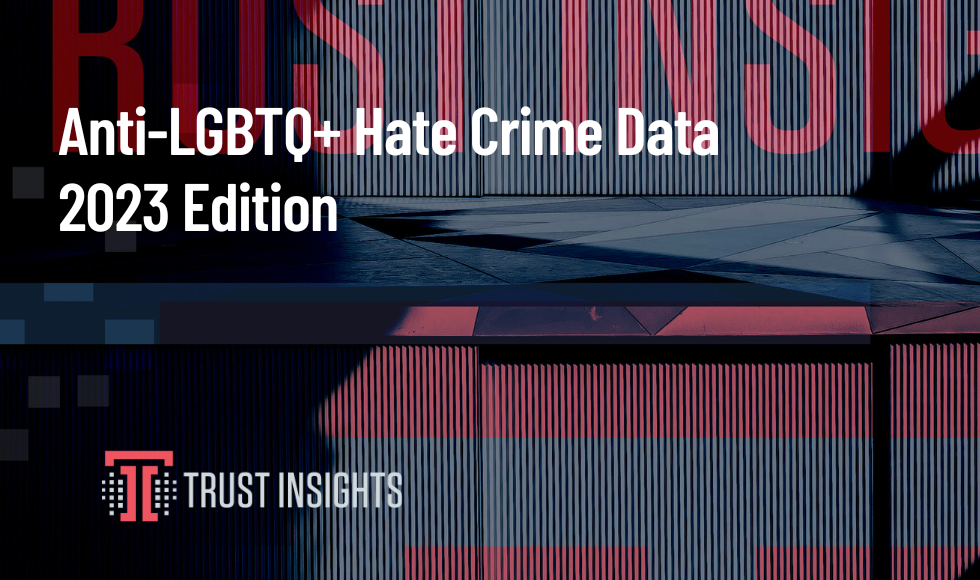








One thought on “Anti-LGBTQ+ Hate Crime Data, 2023 Edition”